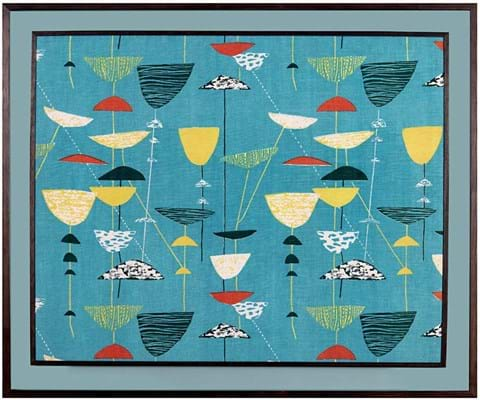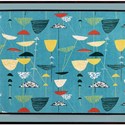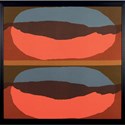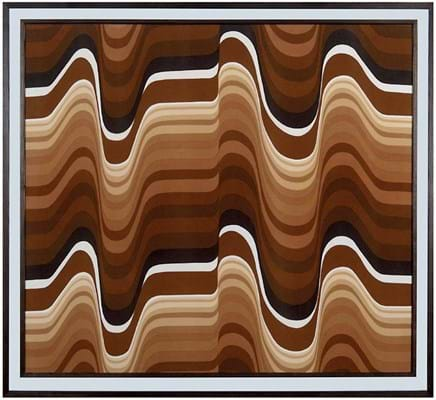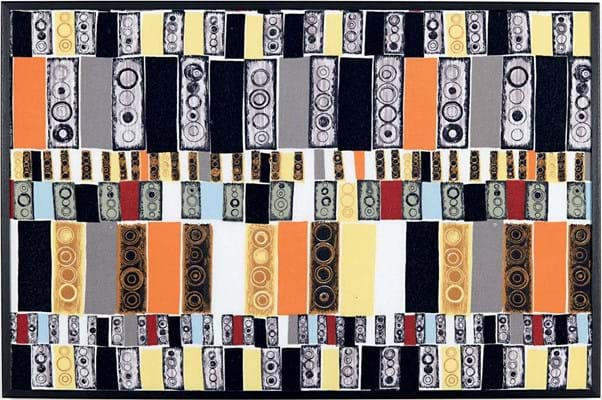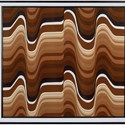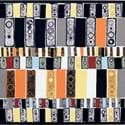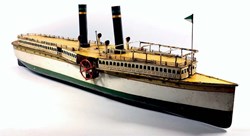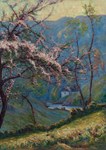In the world of post-war Britain, it was common to have such designs enter the home – not as ‘fine’ artworks but as textiles. These were created by Day and other female designers, many of whom got their start at The Royal College of Art (RCA).
Material Textile: Modern British Female Designers at Messums Wiltshire, an online exhibition co-curated by Gray MCA, showcases these designers and some of their award-winning works.
The exhibition spans the 1950s-70s, when there were particularly close ties between design and wider art movements.
Day’s famous Calyx (a darker but similar concept to Calyx Blue), was produced by Heal Fabrics and presented at the 1951 Festival of Britain. Though inspired by flowers, the forms on it are similar to the twisting forms of Calder or Paul Klee.
Other designers featured here demonstrate the breadth of interests involved in creating their textiles. For example, Austrian-born Marian Mahler (1911-83) moved to Britain in the 1930s, bringing personal experience with the European art world. Her interest in artists such as Calder is suggested in her roller-printed fabrics for David Whitehead
Shirley Craven (b.1934), another RCA student, become chief designer and director of the firm Hull Traders. Her works, such as Kaplan (pictured above), were celebrated for unconventional, large-scale patterns.
Barbara Brown (b.1932), a contemporary of Craven, was dubbed ‘Heal’s Golden Girl’ for her popular and distinctive geometric designs which reflect the ‘look’ of the British 1960s. Among these is Frequency, a favourite of the artist. Inspired by Op Art and geological formations, the manufacturer Heal’s named it after the apparent radio-wave design.
Many of these women started their careers by being more or less steered into textiles during their artistic education. Working with applied art such as fabrics was perceived as a safer and more feminine route than becoming a painter or sculptor.
Their talent was celebrated, nonetheless. Manufacturers would attend their degree shows to snap up choice designs. Today, many are enshrined in the V&A and other museums. Ashley Gray of Gray MCA, co-curator of the show with Messums’ Hannah Hooks, says that today a lively interest exists for the stories of these women and their work.
“There’s a real excitement about colour and atmosphere of these works and the history of the women themselves and why they had to battle so hard,” he says. “These are commercial artists who are also fine artists in their own right, bringing art into people’s homes at a time of austerity. It was an explosion of creativity.”
Planned to run during what turned out to be the full British coronavirus lockdown, the show is hung in the gallery, but remains empty of visitors. The opening was staged over a Zoom call, with ‘attendees’ enjoying a wine or drink of their choice – at home.
Though Gray says that it is disappointing to have visitors barred from a physical show, it has encouraged all involved to think laterally about how to enhance it.
Interviews with the designers are available as podcasts from the Messums website. People may ‘visit’ the exhibition courtesy of a tour conducted by drone, also accessible online. There is also a host of information, including a PDF catalogue, and an extensive plan for sharing the works via social media.
The show follows a recent burst of interest in textile collecting.
As well as the show at Two Temple Place – Unbound: Visionary Women Collecting Textiles (launched in January with many highlights now visible online) – textiles received a special showcase during The London Art Fair in January, where many works found ready buyers.
“I very much hope that people are getting more excited about textiles,” Gray says. “It’s been a specialist area up until now.”
But fresh names, bright modern compositions and affordable prices are likely to attract buyers in any collecting field.


